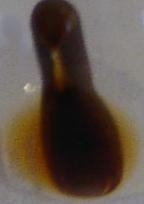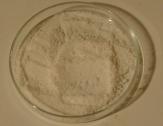to conclude this thread: the first two fractions were redistilled taking
a 15°C cut, the rest (still strongly smelling like P2P) was dumped. 51%
yield despite dumping product. fair enough. amalgum: the distillation was
done slowly, some mixtures just aren't easy to distill, this seems to be
one of them.
the P2P was aminated with standard Al/Hg/MeNO2, A/B, distillation, addition
of equimolar amount of dil. HCl and drying 48h over silica in good yield.
resulting amine had a mp of 133-134°C (lit: 134°C) and was flushed down the toilet.
the mp was taken quickly, that might explain the missing degree.
ps: if you thought that distilling P2P is easy as pie, then distilling meth is
a friggen children picnic: it comes another 10°C lower.
pps: freebase should _really_ be distilled. lots of dirt cannot be removed by
A/B as shown by this before/after/residue series of images:



yumm..
